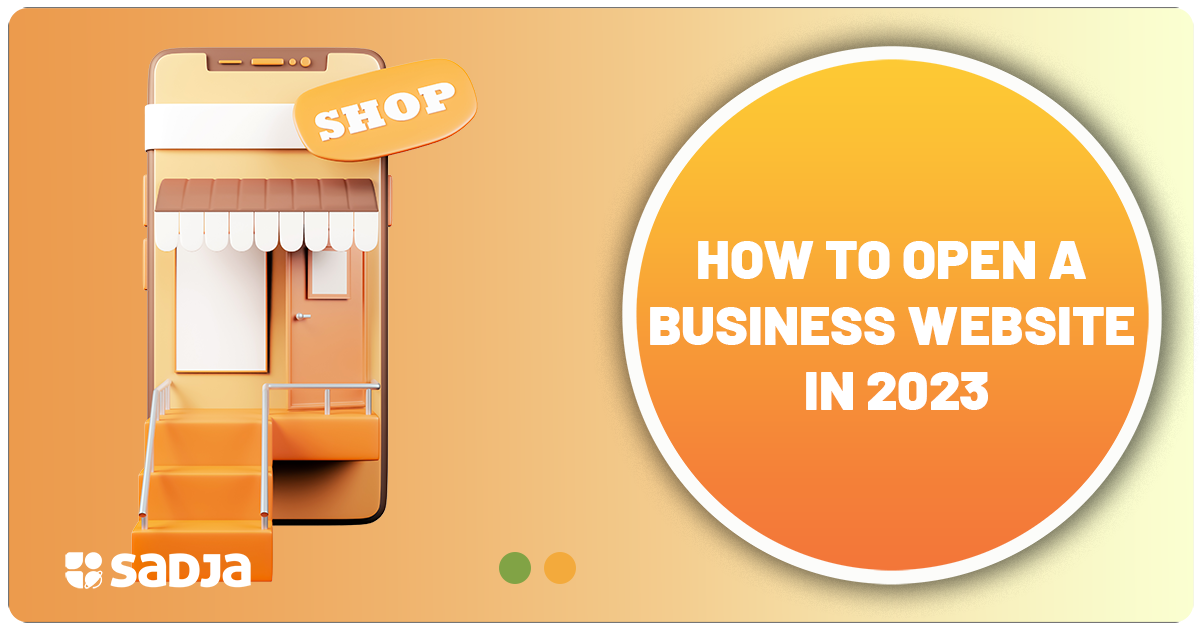Starting a business website can be an intimidating process. But if you want one, there are specific steps you can take and create an effective online presence for your company. Hence, launching a business website doesn’t have to be overwhelming.
A business website is any web page a company or individual uses for commercial purposes. It provides customers with information about products or services offered, contact details for customer service inquiries, and other pertinent data related to the business.
With fast-paced technology, online presence has become increasingly important for companies of all sizes looking to compete in their respective markets. A well-designed website helps build consumer trust while providing access to relevant information.
Additionally, having a robust online presence can help boost visibility on search engine result pages (SERPs), giving you a significant reach when promoting your offerings and acquiring new leads or customers through organic traffic sources such as Google or Bing searches.
This guide walks you through each step of the journey to opening a successful business website, from choosing domain names to promoting your website. But before then, what are the significant benefits of establishing an online presence?
Table of Contents
Why Start A Business Website?
A business website is invaluable for any modern organization, regardless of size or industry. A well-designed and maintained site can provide many benefits to the company, including increased visibility, improved brand recognition, and significant customer engagement.
Increased visibility: A business website allows customers to find your products or services online easily. It also allows you to showcase your offerings professionally, attracting potential customers.
Additionally, a website makes it easier for people to share information about your business with friends and family through social media platforms and other websites. This type of word-of-mouth promotion can be invaluable in today’s digital world.
Improved brand recognition: A well-designed website with consistent branding across all pages helps establish trust with prospective customers by demonstrating that you are reliable and trustworthy. Your site should clearly explain what differentiates you from competitors in the same market.
Furthermore, by providing helpful content such as blog posts or videos on topics related to the products/services you offer, you can further build recognition among target audiences who may not have heard of your brand before visiting your site.
Significant customer engagement: An interactive online presence enables you to engage with customers via comment sections on blog posts or live chat features on your sites. This provides an opportunity to respond to customer inquiries while building relationships through direct interactions.
Additionally, having analytics tools integrated into the back end of a website lets you track key data points such as page views, bounce rates, conversion rates, etc., enabling you to understand better how visitors use your sites so they can make improvements accordingly.
Step-by-Step Guide to Open a Business Website [4 Easy Steps]
Various steps are involved when opening a website for your business. Here is a detailed guide to successfully launching your website.
1. Choose Your Domain Name and Web Hosting Provider
Choosing the right domain name and web hosting provider is an essential first step when opening a business website. A domain name is an address visitors type into their browser to access your site, so it should be easy to remember and relevant to your brand.
When selecting a web hosting provider, consider factors such as reliability, customer service, scalability for future growth, pricing structure, and technical support to find one that best suits your needs. These two tips can help you choose your domain name.
Consider the Branding Potential of Your Domain Name
When choosing a domain name for your business website, there are several things you should keep in mind. First, make sure it’s easy to spell and remember – ideally containing words related to what you do or who you are – so customers can easily recall it without seeing it written down.
Secondly, consider how memorable it will be; try using creative combinations of words or phrases instead of generic terms like ‘business name.com’, which could get lost among other sites with similar names on search engine results pages (SERPs).
Finally, check if the chosen domain is available from generic Top-Level Domains (gTLDs) such as .com or .net. This can help protect against potential cybersquatters attempting to register variations on your brand name to ensure they get traffic intended for yours instead.
Research Different Web Hosting Providers for Reliability and Technical Support
Once you have selected an appropriate domain name for your business website, it’s time to research different web hosting providers before deciding on which one will host your site.
Look at reviews from previous customers, compare features & prices between different companies, and read up on any additional services each company offers, such as email accounts & database management tools, etcetera.
Additionally, make sure that whichever provider you choose has reliable uptime performance records & offers 24/7 customer service & technical support in case anything goes wrong – because nobody wants their site going offline during peak hours.
We have highlighted essential qualities for a web hosting service provider if you still need to determine what to look for.
2. Design and Develop Your Site with an Easy-to-Use Platform or Professional Services
Once you’ve decided on your domain name and web hosting provider, it’s time to design and develop your site. Depending on the complexity of your website, this can be done through a professional service or by using an easy-to-use platform. Here are some tips for each approach.
If Using Professionals
If you hire professionals to design and develop your business website, ensure they have the right experience creating websites. Look for companies who specialize in working with small businesses so they understand what kind of look you want for your website.
Ask them about their past projects and get customer references using their services. This will ensure that you find qualified developers who can help you create the look you want without any issues down the line.
If Going DIY
The other option is to go the do-it-yourself (DIY) route which requires no coding skills whatsoever as most platforms come with prebuilt templates or themes that allow users to customize their sites quickly and easily.
When choosing a template or theme for your website, consider how well it reflects your business’s brand image and its usability features, such as navigation menus, search boxes, contact forms, etc.
Also, keep in mind there are any additional plugins available from third parties, which may be necessary depending on the content management system (CMS) used by the platform provider.
Additionally, if cost is an issue, researching different providers can help save money while still getting quality results at a reasonable price.
3. Optimize your Site For Search Engines (SEO)
Optimizing your website for search engines is integral to opening a business website. It ensures that your content is relevant to specific keywords and can be found by potential customers searching online. Take a sneak peek into three SEO strategies.
Select Keywords That Describe What You Do
Choosing keywords that accurately describe what you do or offer is essential so that people will find you in search results. For example, if you run a pet store, “pet supplies” or “pet store near me” would make good keyword choices.
You can use tools like Google AdWords Keyword Planner to help identify the best keywords for your business website.
Make Sure Content Is Relevant To Those Keywords
Once you have chosen the most appropriate keywords, ensure they appear throughout your content, including the titles and descriptions of blog posts and webpages and within the text.
Content relevancy helps search engine algorithms recognize that your page contains information related to those particular words and phrases, which increases its chances of ranking higher on organic search results pages (SERPs).
Utilize Backlinks To Increase Visibility
Linking from other websites back to yours is another effective way to improve visibility in SERPs since it proves quality content, which Google rewards with higher rankings in their algorithm-driven searches.
Here are credible ways of obtaining backlinks:
Create high-quality content that other websites will want to link to
Reach out to relevant websites and ask them for a link
Take advantage of existing relationships with partners, suppliers, customers, etc., who may be willing to include a link on their website.
Develop relationships with influencers in your industry and leverage those relationships for backlinks.
Participate in forums or online communities related to your industry and provide helpful information encouraging people to link to your website.
Submit press releases about new products or services you offer and company news so publications can reference them when writing stories about your business.
Use social media platforms such as Twitter, LinkedIn, and Facebook to share interesting articles from other sources, which may contain links pointing back at your website.
4. Promote Your Site
Promoting your website is essential to gaining traction in today’s crowded online market. There are a few key steps you can take to ensure your site reaches its target audience and stands out from the competition. Let’s take a look at four ways you can promote your website.
Set Up Social Media Accounts
Social media accounts should be set up for any business that wants an online presence. This will enable you to reach potential customers who may not know about your products or services.
It also allows you to engage with them directly, answer their questions, and provide updates on new offerings or promotions. Before setting up accounts, you must identify which social media platforms your target audience uses the most.
Once established, use these accounts regularly by posting exciting content related to the industry, company updates, and offers for followers.
Publish Blog Posts Regularly
Regularly publishing blog posts provides website visitors with fresh content and helps establish authority within the industry – two things search engines look for when ranking websites in search results pages (SERPs).
When writing blog posts, ensure they are relevant to what people might be searching for when seeking information about your product or service offering(s). Additionally, ensure your content is optimized for search engines.
Finally, link internally (to other website pages) and externally (to other authoritative sites) whenever possible, as it signals trustworthiness and relevance in SERPs.
Take Advantage Of Email Marketing
Email marketing has existed since websites even existed, but it remains one of the best ways to promote your business online.
You can send automated emails containing news about upcoming promotions/products/services, etc., directly into potential customer inboxes to drive more leads to your business. However, you need an email list.
You can create a list by collecting email addresses through forms placed strategically across your site (e-newsletter signup form).
Email tracking software like MailChimp will give insight into successful campaigns, allowing you more control over future messaging strategies based on data collected from past campaigns.
Leverage Paid Advertising
Paid advertising is another meaningful way of quickly driving traffic toward your website without waiting months (or longer) until organic SEO efforts start paying off.
Utilizing pay-per-click (PPC) ads through search engines like Google AdWords allows businesses to target specific keywords associated with their offerings. Hence, they show up prominently whenever your target audience searches related keywords.
Additionally, running PPC campaigns across various social networks provides additional opportunities to expand audience reach by displaying ads directly to users’ feeds based on demographics, age range, etc.
A targeted approach results in higher conversion rates than general display advertisements placed in random locations around web pages since viewers are your ideal target audience.
Final Words
Opening a business website can be daunting if you are unfamiliar with the technical requirements of your business. You need an expert who can advise on your website’s design, optimize the structure and content for search engines and reward your investment.
Sadja Websolutions can create an engaging business website that reflects your brand’s unique personality while driving more traffic to your site, increasing conversions, and ultimately helping you reach new heights in success.
You can book an appointment with us or request a free quote, and we will get back to you soonest.
 +256 206 300885
+256 206 300885



